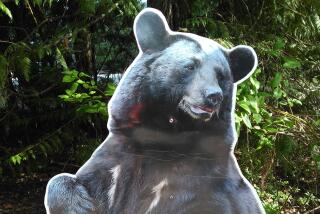The Bear Facts : Sure, Dad’s a bit of a buffoon, and Mom’s rigid and efficient. But more than 100 books later, the ‘Berenstain Bears’ clan is still going strong--as are their seventysomething creators.
- Share via
NEW HOPE, Pa. — Among the enduring mysteries of the universe, there is this stubborn perplexity:
Why is Papa Bear such a doofus?
“But he’s not!” protested Stan and Jan Berenstain, with the cheery tone of unison that inhabits every one of their hundreds of “Berenstain Bears” stories.
Sure, they admitted, he’s a klutz, a buffoon, a hothead and a hopeless incompetent when it comes to anything domestic. As for Mama Bear, breathes there a more rigid, uptight and demanding dervish of household efficiency?
“Look,” said Stan, letting the world in on a little just-between-you-and-me family secret. “I was told by a lawyer once that truth is a complete defense. Mama’s perfectionism is about Jan.”
And Papa’s bullheadedness?
He nodded. “Yep. That’s me.”
In short, the Berenstains agreed, typical role models, parents who have withstood the test of more than three decades in print. The Berenstain Bears have appeared in more than 100 books; even their creators have lost track of the exact number. The Bears series has sold more than 200 million copies in dozens of languages worldwide. Most recently, the Berenstains found themselves translated into Hungarian.
Now, for a little literary variety, the husband-and-wife team has ventured back into the realm of grown-up writing. “What Your Parents Never Told You About Being a Mom or Dad” (Crown, 1995) represents a homecoming of sorts, since “Berenstains’ Baby Book” (MacMillan, 1951) was their first title.
That was the book they wrote on the invitation of an editor friend who could not stop laughing at their tales of trying to raise baby Leo (now 46) in an un-air-conditioned flat above an Army-Navy surplus store in downtown Philadelphia. At the time they were 24, and starting to become known for their cartoons and covers in magazines such as Collier’s and the Saturday Evening Post.
Now that they are 71 and grandparents of four, the Berenstains still marvel about how the species manages to perpetuate itself. Disposable diapers may be an invention on a cosmic par with the wheel, they concede in their new book, but one day the Statue of Liberty will look down to see herself “buried up to her neck in a deep endless blanket of something, something non-biodegradable.” And sleep deprivation, they reveal, is the dirtiest parenting secret of all.
“Our sons (Leo was soon joined by a brother, Michael) have often asked us why we never told them how terrible it was not to be able to sleep,” Jan said.
“If we had,” interrupted Stan--like Papa Bear, the more loquacious of the pair--”they never would have had kids of their own. You know, in some cultures, that’s how they torture people, by not letting them sleep.”
Better dressed than their ursine counterparts, Stan and Jan nonetheless do possess some resemblance to . . . well . . . bears. Here in the affluent serenity of Bucks County, about 40 miles and a million light-years from their old address in downtown Philly, they live in a house replete with wood and stones, and blessed with an endless view of thickets and meadows. They emanate coziness, built on 50-plus years of sharing an easel and finishing each other’s sentences.
They met on their first day as art students in 1941, falling in love instantly, they both affirm.
“I loved your drawing,” Jan said, the years melting as she gazed at her husband.
“I still remember what you had on,” Stan replied.
“You were wearing soldier pants,” Jan said. “And a plaid flannel shirt.”
World War II separated them, sending Jan off to work as a riveter and Stan for a military hitch that ended with him doing medical illustrations for an Army plastic surgeon. Thirteen days after his discharge in 1946, they were married. They promptly set to work on a joint career, doing illustrations and humorous sketches.
“I had become very interested in cartooning,” Stan explained. As a career path, “I thought, gee, that looks like fun.”
He began sending the drawings off to a publication called the Saturday Review of Literature. “And I got back a response from a man named Norman Cousins, who said, ‘Great stuff, corporal, send more. We’ll pay you $35 apiece.’ I thought wow, what a racket.”
*
Their magazine cover art brought them the “astronomical” sum of $1,000 per illustration. “Berenstains’ Baby Book” led to nearly two dozen other books about family life.
Nominally geared to adults, those books bore such titles as “Marital Blitz,” “How to Teach Your Children About Sex Without Making a Complete Fool of Yourself” and “Have a Baby, My Wife Just Had a Cigar!” By today’s standards, these humorous paperbacks might seem terminally corny, but Stan regards them as rather distinguished. “We try to dignify them by calling them cartoon essays,” he said.
Then Stan happened upon a New Yorker profile of a Random House editor, Theodor Geisel, who was launching a line of rhyming books for young readers. The Berenstains went to see the man better known as Dr. Seuss, taking with them what they called “a bad imitation of Ogden Nash.”
Geisel looked at the manuscript, Stan recalled of the slim little effort that became “The Big Honey Hunt” (1962), “and said, ‘This is going to be a great book.’ ”
Stan responded with what he calls his “suck-up line”: “We know you’re a genius, Ted.”
But to this day, they insist that no one was more surprised than the Berenstains themselves when an ongoing series was born. They were well into a new book about penguins, they recalled, when Geisel called to report, “We’re selling the hell out of the bear book.”
They chose bears not because of any euphonic similarity to their surname, but because bears are furry and appealing and because it’s fun to dress them in silly clothes.
Besides, Stan said, female bears “are terrifyingly good mothers.” The males, meanwhile, “make lousy fathers.”
*
Without so much as consulting them, Geisel renamed Stanley and Janice Berenstain, dubbing them Stan and Jan, as they have been known forever since. He also slapped the phrase “Berenstain Bears” on succeeding covers.
“He said it was like a vaudeville act, like Murgatroyd’s Mules,” Stan said. “It was a brilliant marketing tactic.”
That shrewd merchandising strategy helps to account for what has proven to be the steady allure of the Berenstain Bears, said Ginny Moore Kruse of the Cooperative Children’s Library at the University of Wisconsin.
“As soon as you have something which people who are now parents remember reading when they were children, it becomes a family experience,” Kruse said. “There is a nostalgia connected to the stories, a subjectivity” that transcends the occasionally simple-minded quality of the prose and drawings.
“Plus, there is all this behavioral stuff,” Kruse said, referring to the carefully ordered social structure of Bear Country. “You have the values thing, which probably many parents agree is a little moralistic, but they say, ‘I want my child to know about this.’ It kind of fits in with a lot of peoples’ hopes for their kids.”
Dealing with first-time experiences and many of the ordinary, yet vexing, issues of family life, the Berenstains “meet current concerns, and they do it well,” said Margaret Coughlin of the Children’s Literature Center at the Library of Congress in Washington. “They are supportive and non-threatening. They offer parents a sense of assurance.”
The fact that they are inexpensive also works in their favor, Coughlin said, adding: “There are other books that do the same thing, just more expensively.”
For their part, the Berenstains have little use for those who scorn their low price tags (the Berenstain Bears “first time” paperbacks cost $2.25) or their presence in grocery stores.
“I approve,” Jan said. “I know where the mothers are.”
*
The Berenstains work constantly. They map out story lines together. One partner, usually Stan, does a first draft of text, while the other refines and trims, paring the copy down to a sparse 1,100 words. The drawings are equally collaborative.
“He’s better at perspective,” Jan said.
“She knows color,” Stan rejoined.
Both obviously know a good story line when they invent one. Even so, they may have trouble evaluating it. In early editorial meetings, when Geisel challenged them to define the relationship between Papa Bear and Brother Bear, Stan said he was mystified by the search for psychological complexity.
“I said, ‘Well, he’s the father, and he’s the son,’ ” Stan said.
But Jan said the model for the father-son dynamic was borrowed from the 1931 Wallace Beery-Jackie Cooper movie, “The Champ.”
“Beery was always stumbling and getting into trouble and Jackie always got him out,” she said. “But he always respected him afterward.”
“It’s like Papa Bear,” Stan elaborated. “He may be a bumbler, but he often saves the day.”
That quality automatically appeals to children, said Anne Connor, coordinator of Children’s Services for the Los Angeles Public Library.
“I think they like the fact that the father is kind of a fool,” Connor said. “Isn’t it kind of comforting to think that the guy who is so authoritative--the guy who’s always yelling at them--is wrong?”
Clearly, the formula works. Papa Bear, Mama Bear, Brother Bear and the eternally feisty Sister Bear confront new neighbors, playground bullies, fibbing, messy rooms, fear of the dark, visits to the dentist--all the daily terrors of normal life. Their new chapter books, for fledgling readers, explore these topics still more. In their newest grown-up book, the Berenstains address such matters as gonads, and why children are naturally superior to dogs and cats.
(“A dog gives you perfect love, a cat total rejection,” they write. “A child offers the advantage of giving you perfect love and total rejection--often simultaneously.”)
But “The Berenstain Bears Retire” is probably not a title that will come out soon. When people ask if they plan to slow down, Stan said, snorting in derision at the mere suggestion, “I say we’re just going to keep doing it”--and they looked at each with affection, much like Papa Bear and Mama Bear--”until we get it wrong.”
More to Read
Sign up for our Book Club newsletter
Get the latest news, events and more from the Los Angeles Times Book Club, and help us get L.A. reading and talking.
You may occasionally receive promotional content from the Los Angeles Times.







